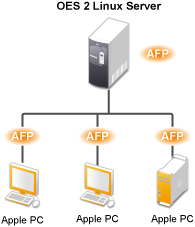1.1 Understanding AFP
Novell AFP (Apple Filing Protocol) lets Macintosh workstations access and store files on OES 2 SP3 without installing any additional software. The AFP software is installed as part of OES and provides out-of-the-box network access. You can connect the network cable, start the Macintosh computer, and you have access to servers on your network.
Novell AFP enables the Linux server to use the same protocol as the client workstation to copy, create, delete, move, save, and open files on a Macintosh workstation.
Figure 1-1 Novell AFP Overview

Enabling native protocols on a Linux server means that users can access files on the network, map network drives, and create shortcuts to the Linux servers by using the native methods available in their specific operating systems. Macintosh users can use Chooser or the Go menu to access network files and even create aliases. The native protocols that run on a Linux server enables the users to seamlessly copy, delete, move, create, save, and open network files— just like they would if they were working locally.
AFP also provides integration with Novell eDirectory. Consolidation of user management through eDirectory simplifies network administration. All users who need access to the network are represented in eDirectory through User objects, which enables you to easily and effectively assign trustee rights, control access, and manage all user objects from a single location on the network.
Novell AFP is currently supported only on the NSS file system and it can be used for accessing files on NSS volumes.
1.1.1 AFP and Universal Password
Universal Password helps in management of password-based authentication schemes.Each AFP user must be Universal Password enabled to be able to log in to the AFP server.
The Universal password is not enabled by default.
For details on Universal Password, see Novell Password Management